Project Saras

Cranes are the tallest flying birds on earth and they are known for their Majestic posture and grace. They are revered in various cultures as birds of heaven and as ancestors. In India 5 cranes can be found: The Siberia Crane (though has not been seen for over 8 years now), Black-necked Crane, Common Crane, Demoiselle Crane and the Sarus Crane. Of all these only Sarus Crane is resident of India and rest are winter visitors.
Sarus crane is the tallest of all cranes hence the tallest flying bird in the world. The Sarus crane is found in North and North West regions of India. They are the state bird of Uttar Pradesh.
Sarus crane grows up to 6-7 feet in height. They have a red head that gives them a beautiful appearance. To know more about them pls. visit www. ogaclicks.com/wordpress/galleries/cranes-stork/
This bird is declared as VULNERABLE in IUCN conservation status. It was a dream to capture the breeding process on camera for future generations .
This article is upon their breeding habits and my experience on photographing them during this whole process.
Sarus cranes are ready to breed from 2nd year after birth. They form a pair that is lifelong (at least till a partner dies). They breed in the months of July-Sept, espl when the rain starts. The courtship is a long process where in the pair dance together and let out loud trumpeting calls. The calls are very loud because of the long coiled trachea in their neck. The dance is a series of Jumps and hops followed by wing flaps and then a display where the pair will stand tall, stretch their necks high and give a loud trumpeting call. The calling is also done when the “Lek” or nest is under threat but usually repeated multiple times in courtship time.
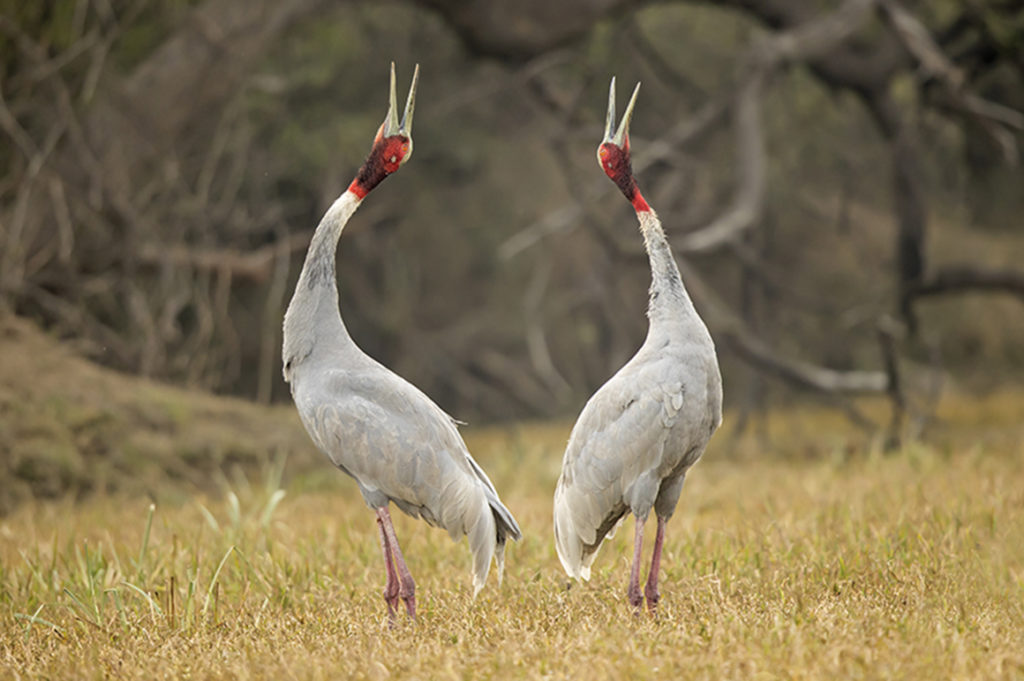 The trumpeting call
The trumpeting call
 The Courtship dance
The Courtship dance
Once the birds have paired, then they look for nesting sites. The choice of nesting sites is baffling because either they are very far from human disturbance or they are right there in middle of a rice fields surrounded by humans. My understanding is that basis their past experience they choose their Nesting sites. Those pair that were undisturbed by Humans choose a place near them while those with bad experience will move away.
The site is usually in middle of a wet area like a pond or inundated rice field. They choose a slightly raised area like the “bund” that separates two fields. They will start building the nest by placing long grass, wetland plants and large twigs to form a large saucer. This is about 3-6 feet in diameter.
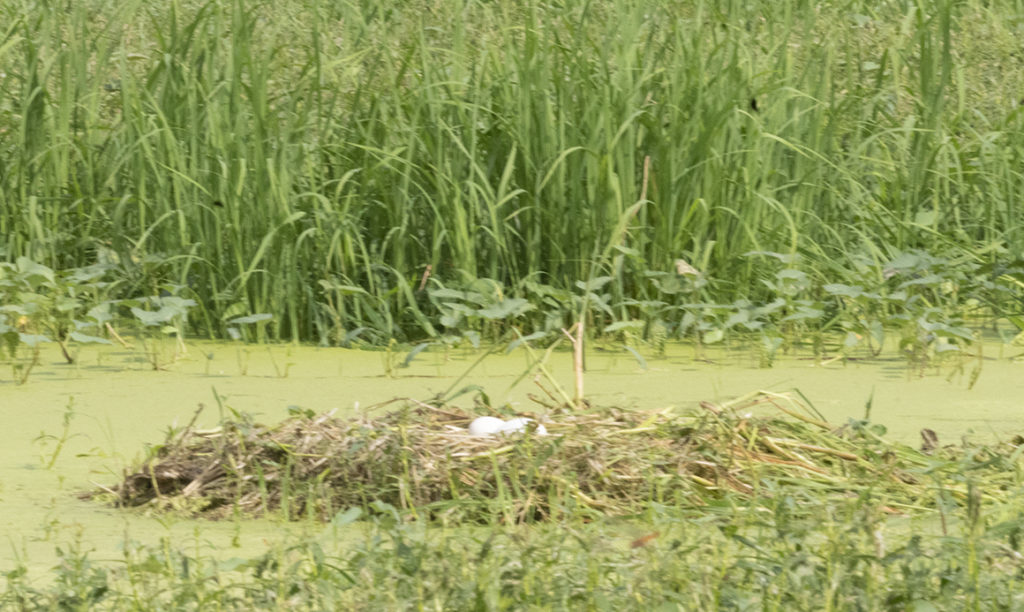 The nest with two eggs
The nest with two eggs
The nest building is an on-going process and even after the eggs are laid the male will keep refurbishing the nest and making it larger.
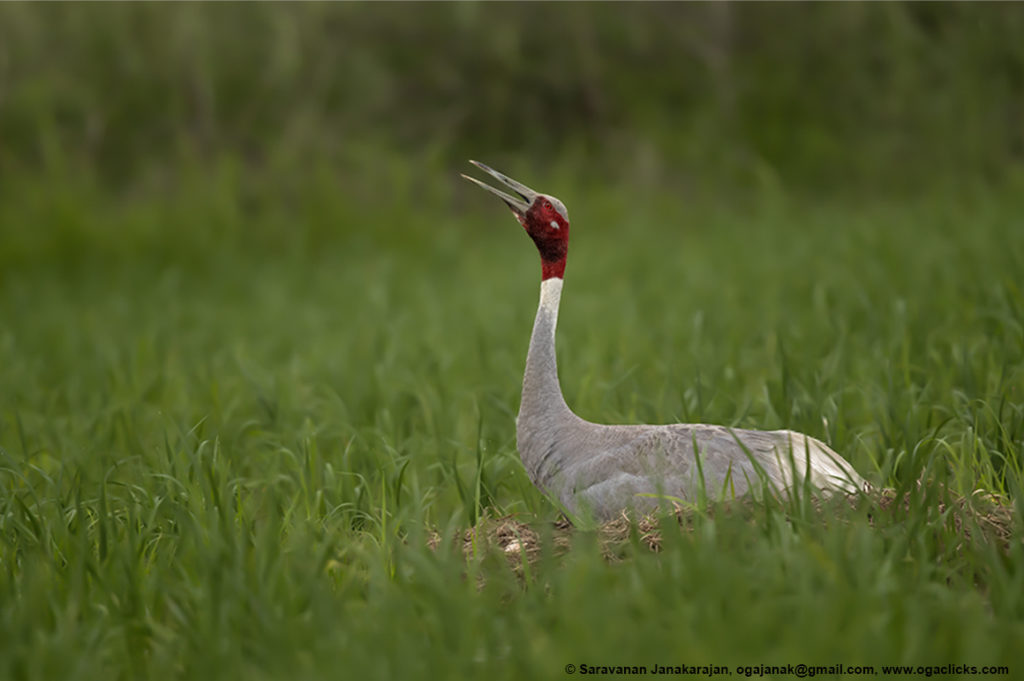 Incubation of eggs
Incubation of eggs
Once the nest is to the satisfaction of the pair they lay a clutch of two eggs. The eggs are laid in interval of 24 hours. Incubation is by both partners but I observed that the female spends more time at nest than the male during incubation as well as when the chick has hatched. The male and female take turns to go far from the nest to feed. Their return flight to nest is also a circuitous one and they land far from the nest. This is to fool any predator that could see them and trace their nest. The nest is protected with great zeal by both the partners. The bird will not hesitate to attack any predator or anybody causing disturbance to the nest.
The incubation is done for 31 days. The egg hatching is asynchronous. The first chick comes out 24-36 hours before the second chick.
First chick with eggs
The chick is all wet as it comes out. The mother will help the chick come out of the egg. It will remove the egg shells from the hatched egg to help the chick come out free. The male will then pick the egg shells and bury them in the ground.
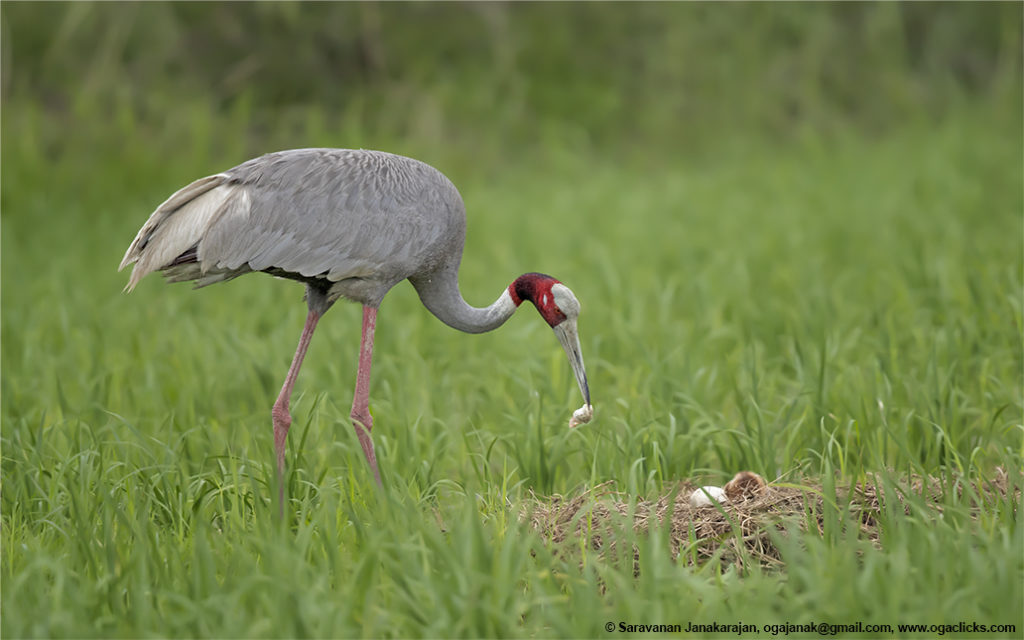 Egg shells being removed
Egg shells being removed
Some of the shells will be eaten to overcome the exhaustion of incubation. I saw a lot of crows and Ibis attracted to the nest more for the shell than for the chick. The male has to do a good job of burying the egg shells else the nest and chick will be in danger.
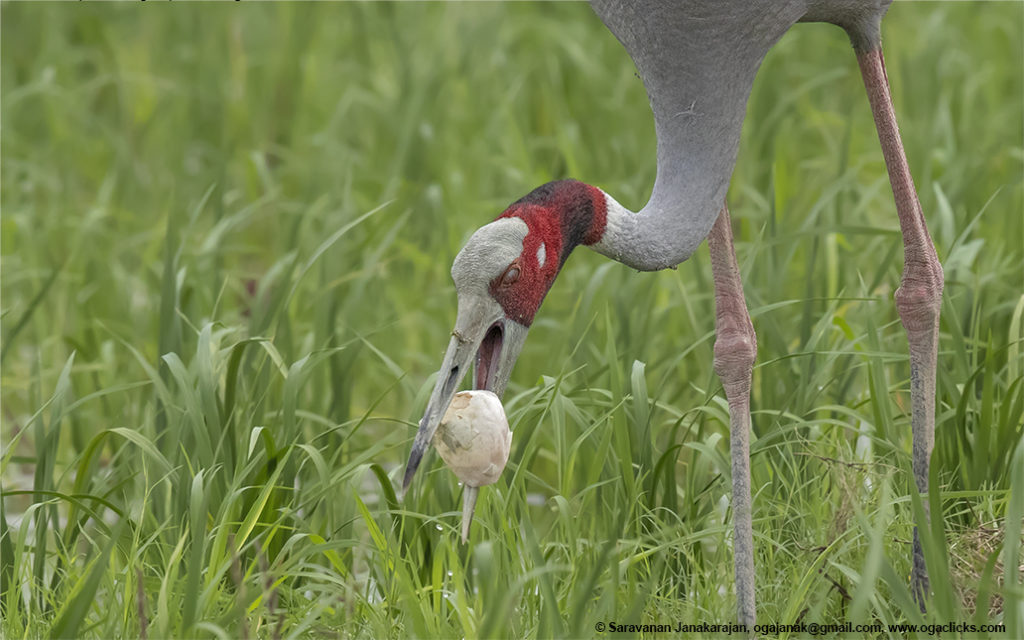 Egg shells being buried in field
Egg shells being buried in field
The parents keep rolling the egg to ensure that it is warmed uniformly.
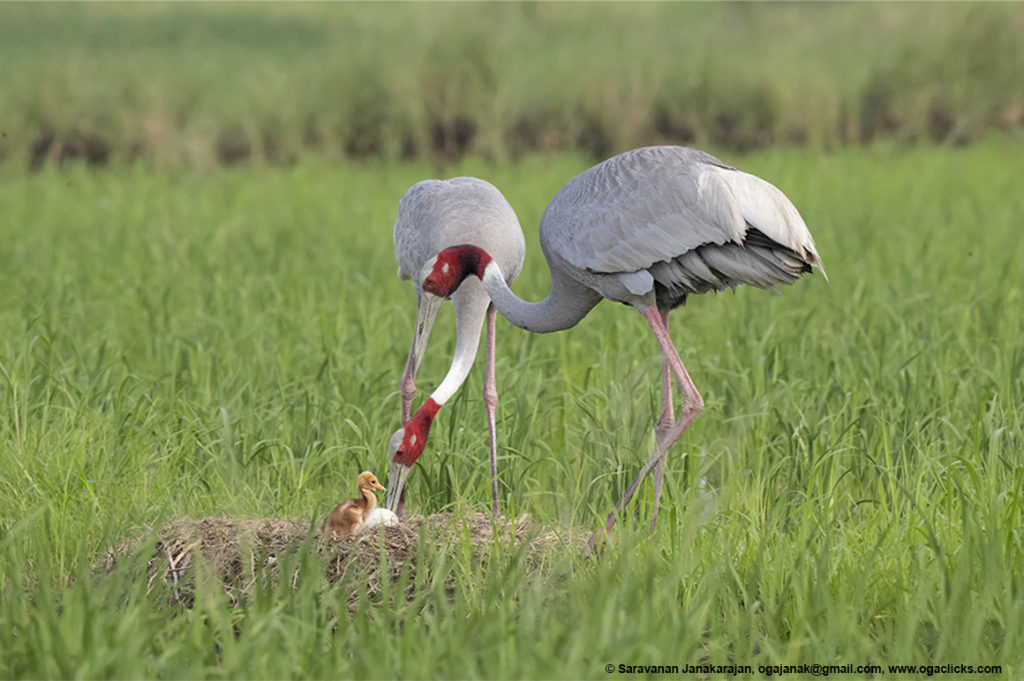 Rolling of eggs
Rolling of eggs
The chicks take a day to gain its bearings. It keeps falling down and is always close to its mother. The chick keeps going inside the mother’s wings to dry itself. As the weather is moist and usually rains the chick spends most of the first day under the wings of the mother or father.
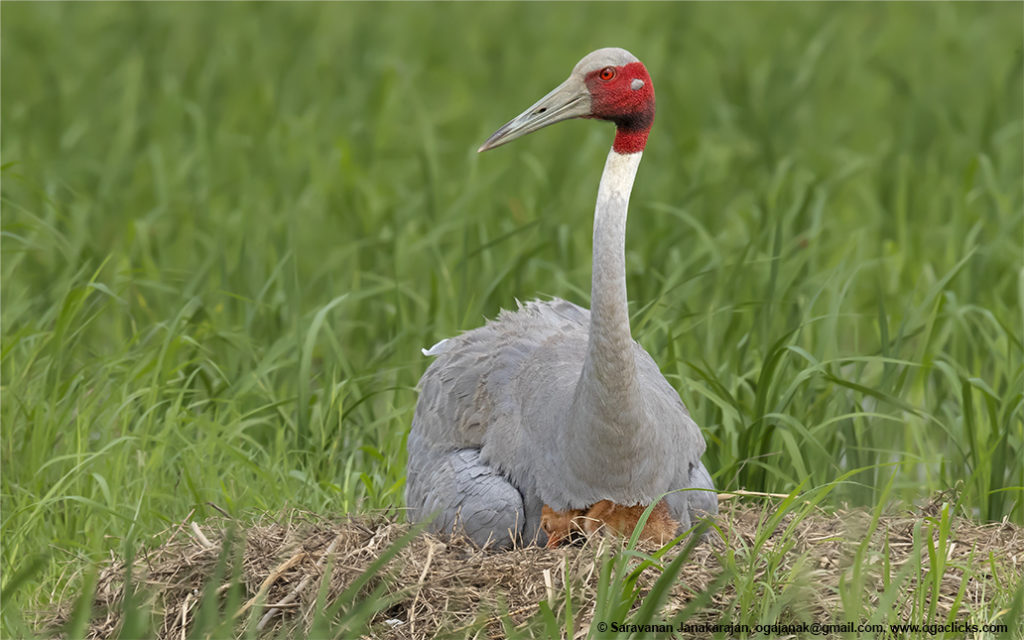 Chicks hiding under mothers feathers
Chicks hiding under mothers feathers
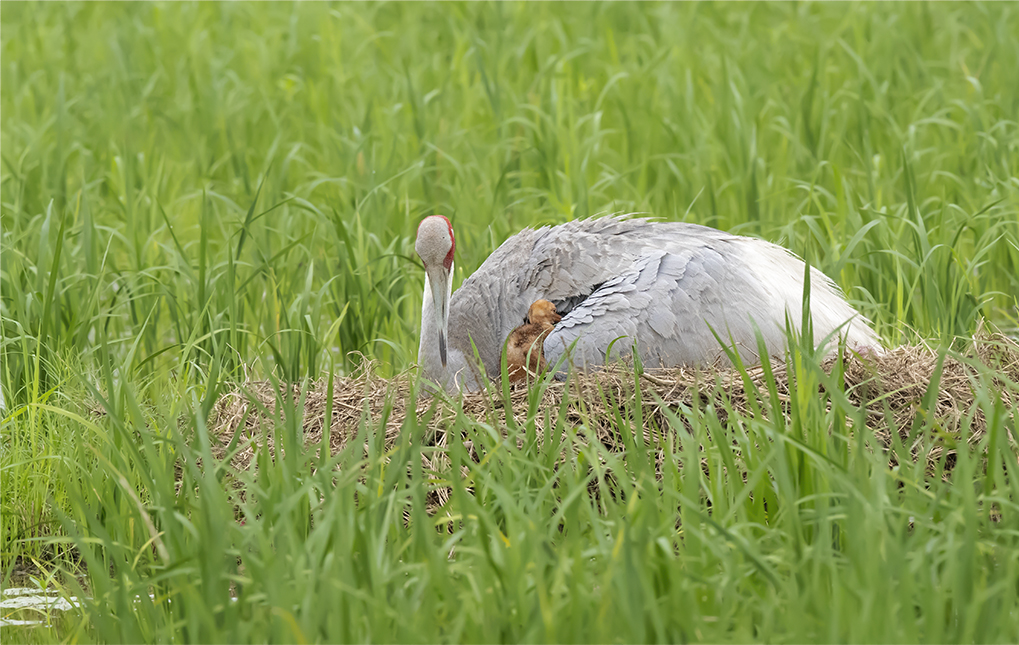 Chicks hiding under mothers feathers
Chicks hiding under mothers feathers
The father takes a longer time to eat and return to the nest and relieve the mother. The mother is a quick eater and she feeds much closer to the nest. The male spends more time protecting the nest than with first chick or incubating the second egg. The mother spends more time sitting on the egg than before as she has to ensure the hatching in next 24-36 hours. The hatched chick also sits along with the egg to get the heat from mothers body to dry faster.
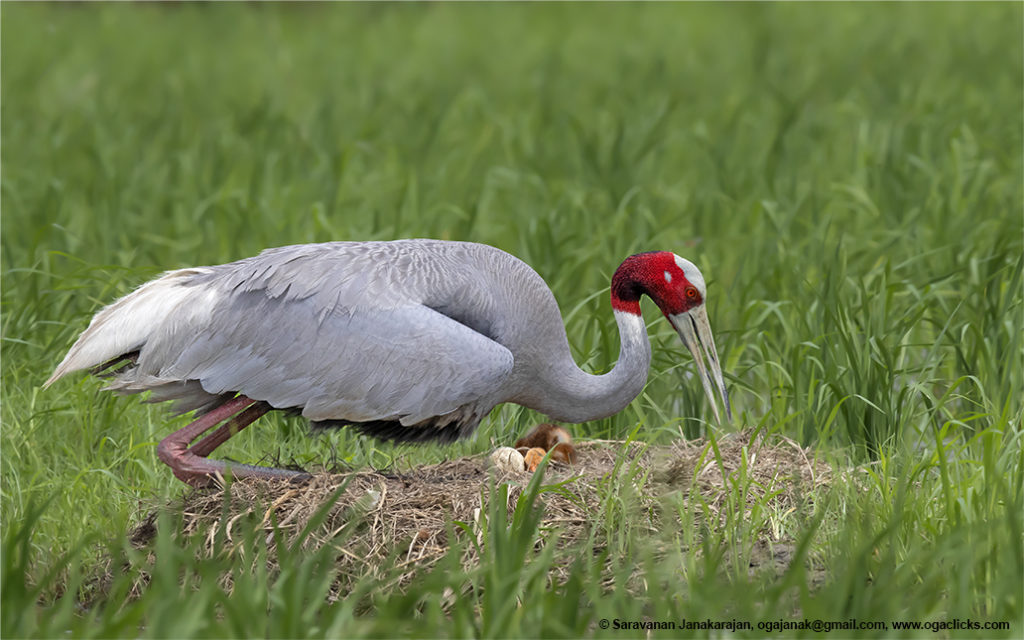 Hatched Chick also incubating with the egg under mothers feathers
Hatched Chick also incubating with the egg under mothers feathers
The first chick dries up in 12-16 hours and finds its feet soon. It becomes adventurous and ventures out of the nest with its father. The father feeds the chick post 12-16 hours only. It catches small insects from the grass and feed them to the chick.Initially through its beak and then after some time drops the insects in the nest and the chick then eats it up.
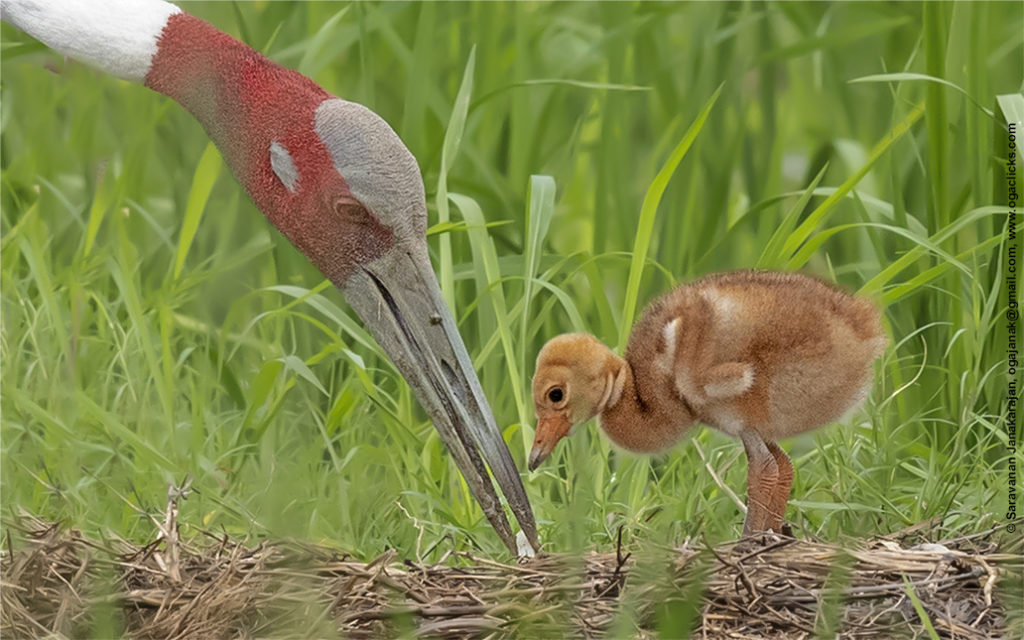 The father feeding the chick in the nest
The father feeding the chick in the nest
The second egg hatches 24-36 hours post the first egg. The second chick also goes through the same routine as the first chick.
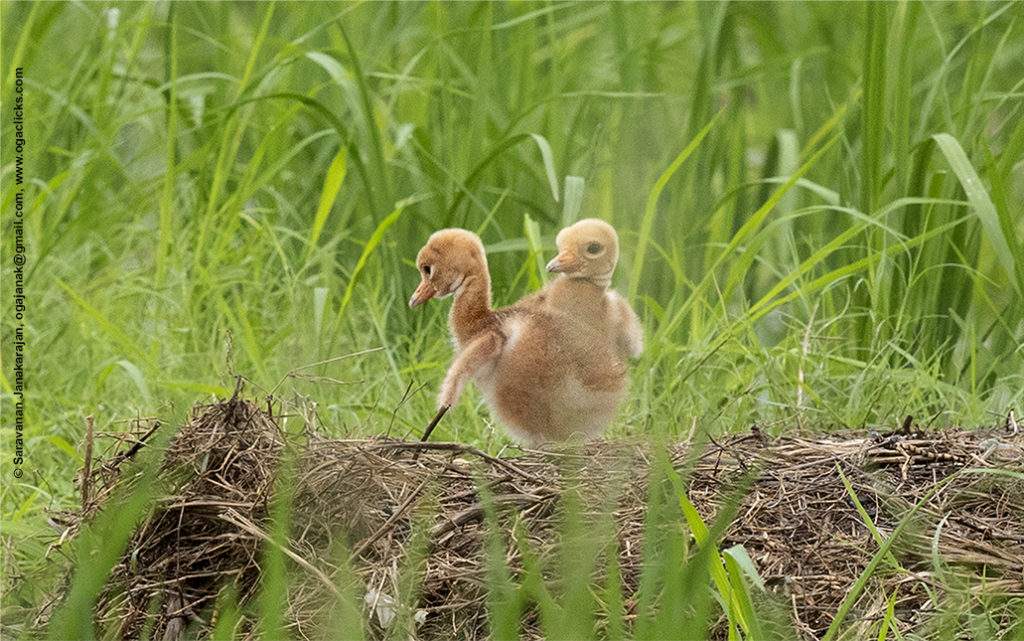 Both the chicks in the nest
Both the chicks in the nest
The mother has to be in sitting position for longer as both chicks compete to hide under its wings. I observed that the exhausted parents tend to eat more of the egg shells from second egg than the first.
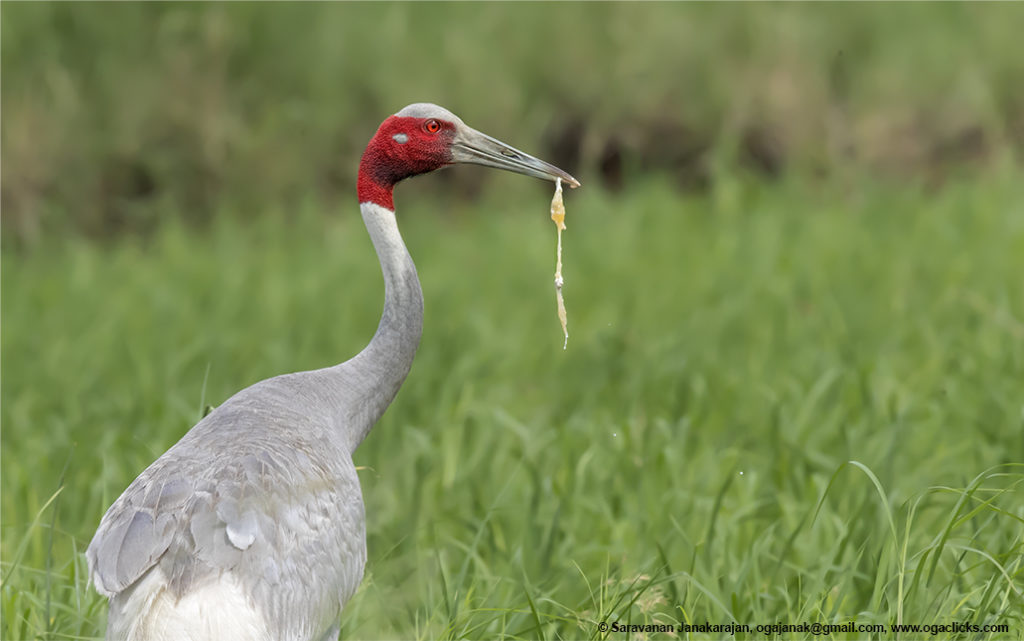 Mother eating the egg shells
Mother eating the egg shells
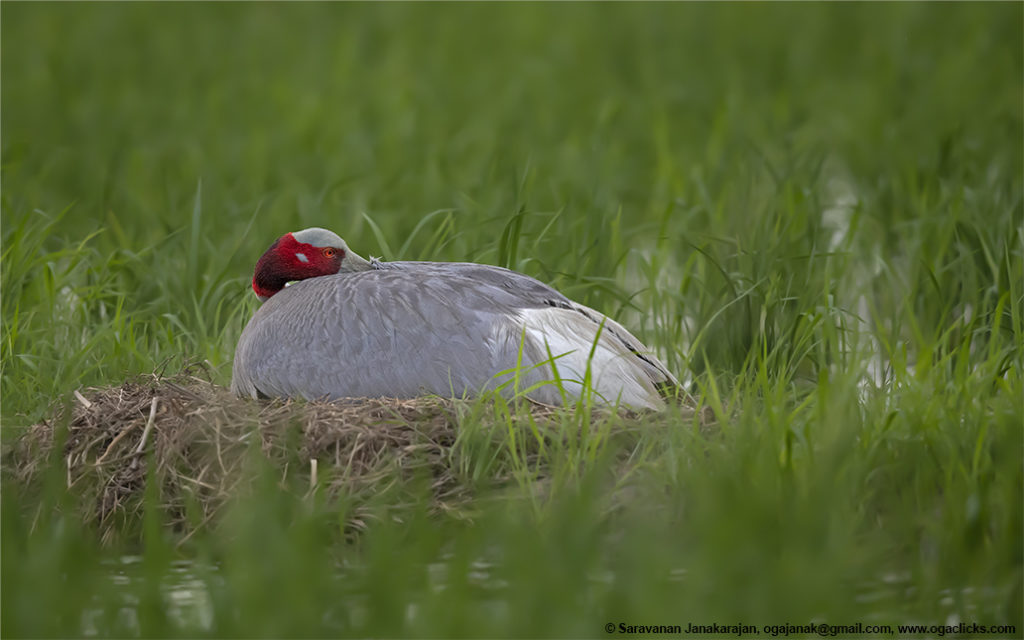 Exhausted mother in the nest
Exhausted mother in the nest
The father is now really very agitated and on guard with two chicks out and he has to protect them. Even slightest disturbance can cause the parents to go into the calling mode and it’s a sight to see the parents stand tall, raise their necks and extend their beaks skywards and call out loudly. The male also balloons its feathers into a ball. It is a magnificent sight. The chicks hide in the nest as a survival behaviour.
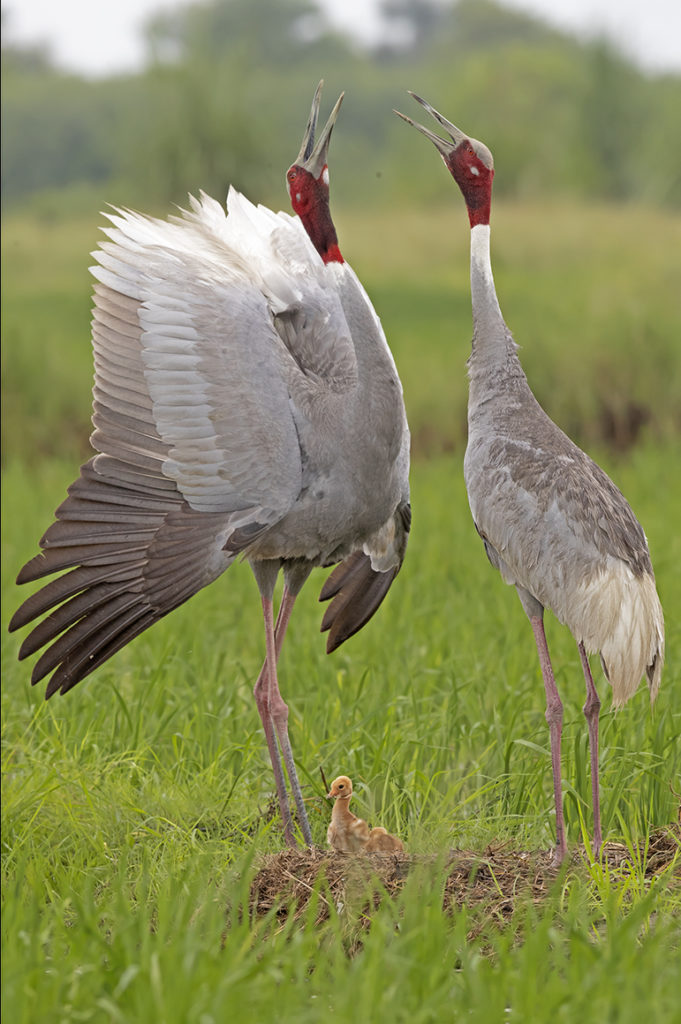
The parents are quick to give the warning call , aloud trumpeting call. One chick is hiding while other is curious
Each parent takes a chick and looks after them by feeding them and supervising their adventures as they venture out of the nest
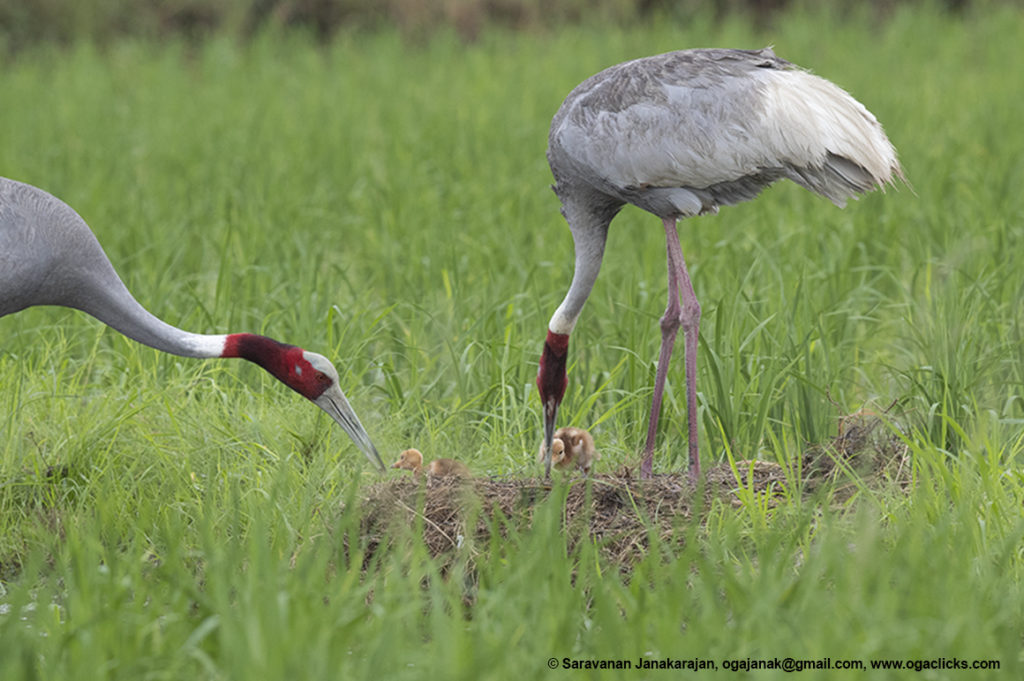 Each Parent feeding one chick each
Each Parent feeding one chick each
What amazed me is the sight of this 6 feet bird standing tall with its chick about 6 inches long. It is amazing to see the contrast and a photographer’s nightmare to capture them in the same frame. It tests your equipment capability and your skill in exposing them perfectly and getting them both sharp. I have never been more proud as a photographer when I got all 4 of them sharp.
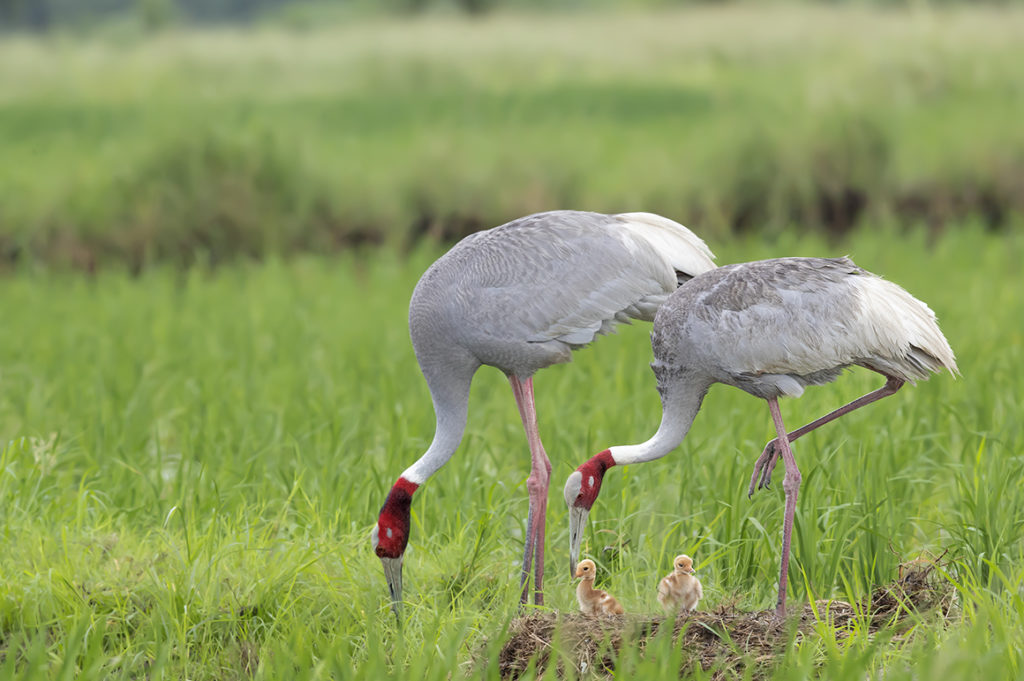 The complete family: Hum doh , hamare doh
The complete family: Hum doh , hamare doh
The male will get to work and start catching insects and feeding the chicks. This is a whole day process. The chicks are fed throughout the day. The chicks have to be mobile in 24 hours. (the first chick is at advantage here).
The parents will slowly lead the chicks away from the nest to test their comfort levels. The chicks will be adventurous but will also seek the protection of nest. After several repeated efforts the Parents will lead the chicks away from the nest and walk away into the fields. The chicks will now have to live of the land and sleep in temporary nests built by parents every day.
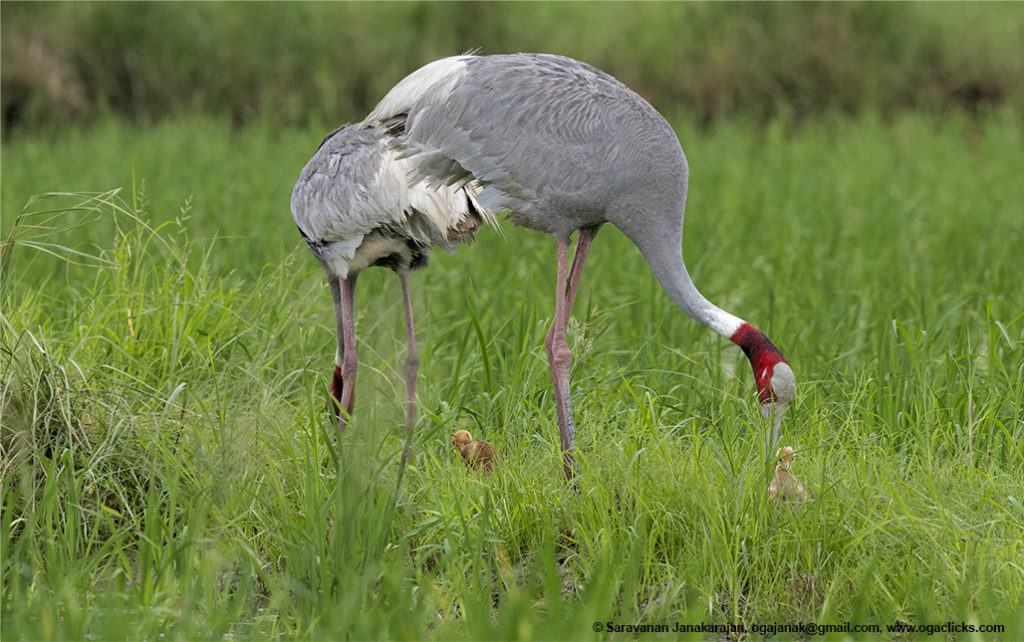 Chicks are lead away from nest by parents
Chicks are lead away from nest by parents
The growth rate of the chicks is amazing feat of nature. The chicks weigh 125 gms. at birth and weigh more than 1 kg by 30th day. They are about 6-8 inches on birth and grow up to 2.5 feet end of 30 days. They attain their full height by 12 months.
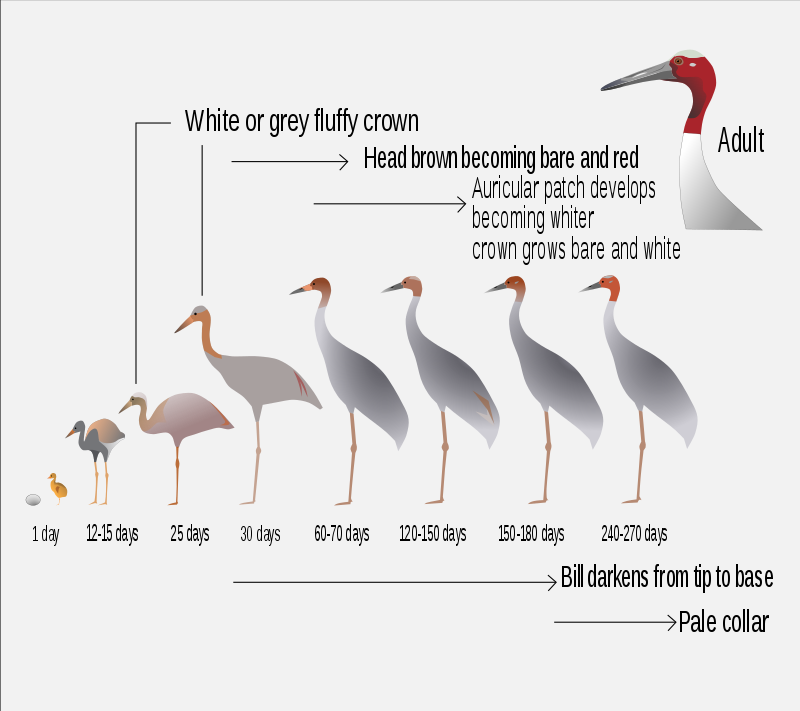
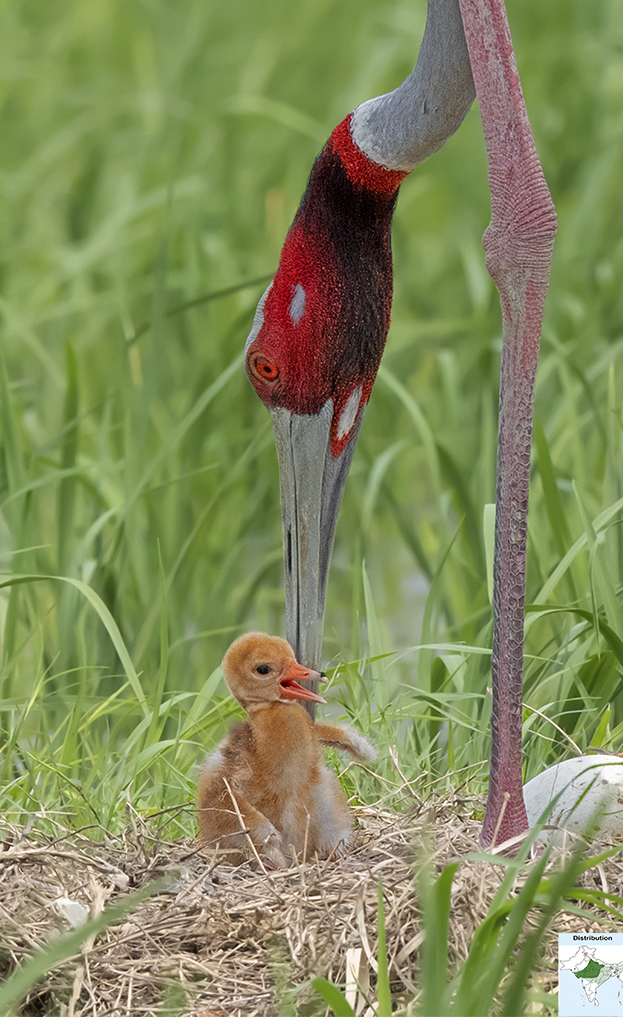 The chick is smaller than the beak of an adult : Gives a idea of size proportion
The chick is smaller than the beak of an adult : Gives a idea of size proportion
The chicks turn into sub-adults and then adults by 2 years. They still stick to their parents. Post one year the parental pair is ready to breed again. The mother will force the sub-adult to leave them. Sometimes a few warnings are good enough and sometimes the mother has to use its beak to goad the youngsters to go on their own ways. The process starts again.
I have been fortunate enough to see this process over a year and capture the images of most of the stages. While it is frowned upon when the nest photography comes into picture, one must understand that Saras is a very large bird . It is very comfortable with humans being in vicinity. To capture these images I was more than 500 feet from the bird.
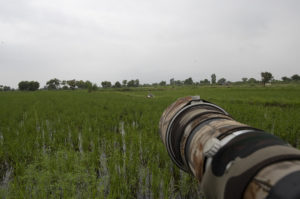 Positioned ourselves far from nest
Positioned ourselves far from nest

The pair was very comfortable with us. It went about its routine as usual and didn’t even give us any threatening look. There were farmers who were much closer than us. There was a religious function with tents etc. put up about 100 meters from them and the birds were ok with it.
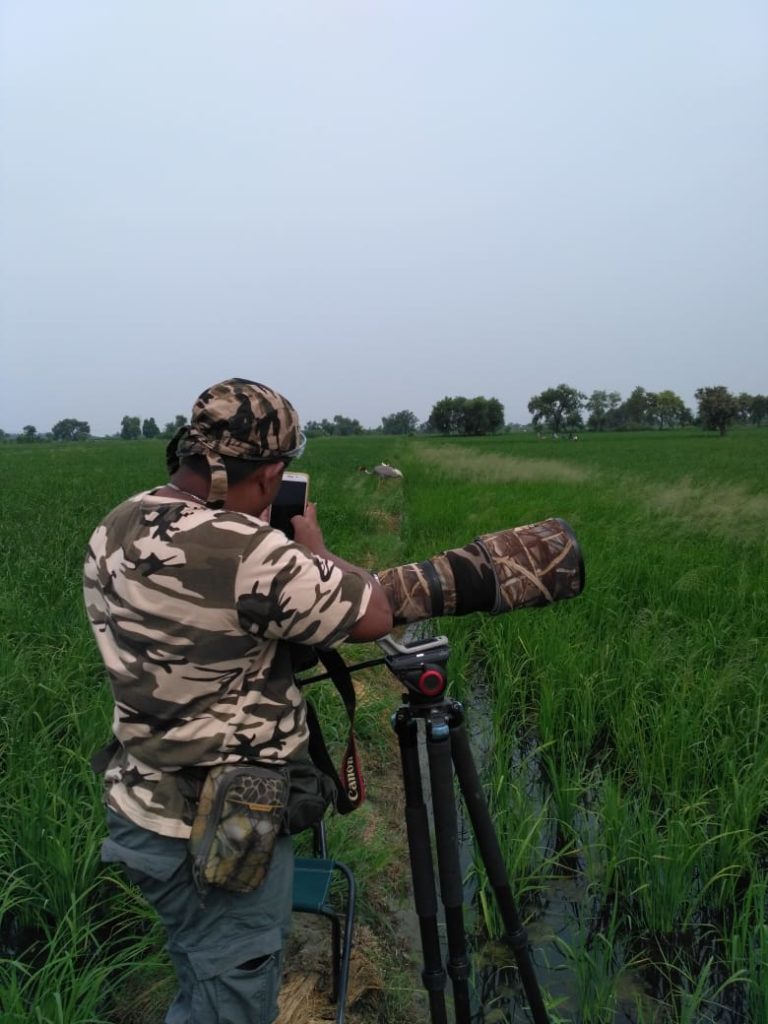 The male walks past me without any disturbance.. sitting there for two days , we had become part of landscape for them
The male walks past me without any disturbance.. sitting there for two days , we had become part of landscape for them
This whole process was planned for a long time and when we identified a nest we kept counting the days till we could get there for capturing the chicks with parents. We had to wade through some tough areas in rice field. We avoided the bunds to ensure that the bird is not alarmed. We stopped far enough to get decent pictures and also outside the Circle of confidence of the bird. With a reach of 700mm the bird was frame filling from more than 500 feet.
The approach to the birds nest was a tough one and definitely not for the weak hearted .
 Bird photography is all about waiting for the right moment
Bird photography is all about waiting for the right moment
I have waited more than a month to write this blog and put out the pictures because I didn’t want to expose the nest site and drive photographer traffic towards the site.
We also educated the people in villages about the importance of these birds and their vulnerability during this period. Honestly we found many farmers who were okay with the birds being in their fields and they were more knowledgeable about them than us.
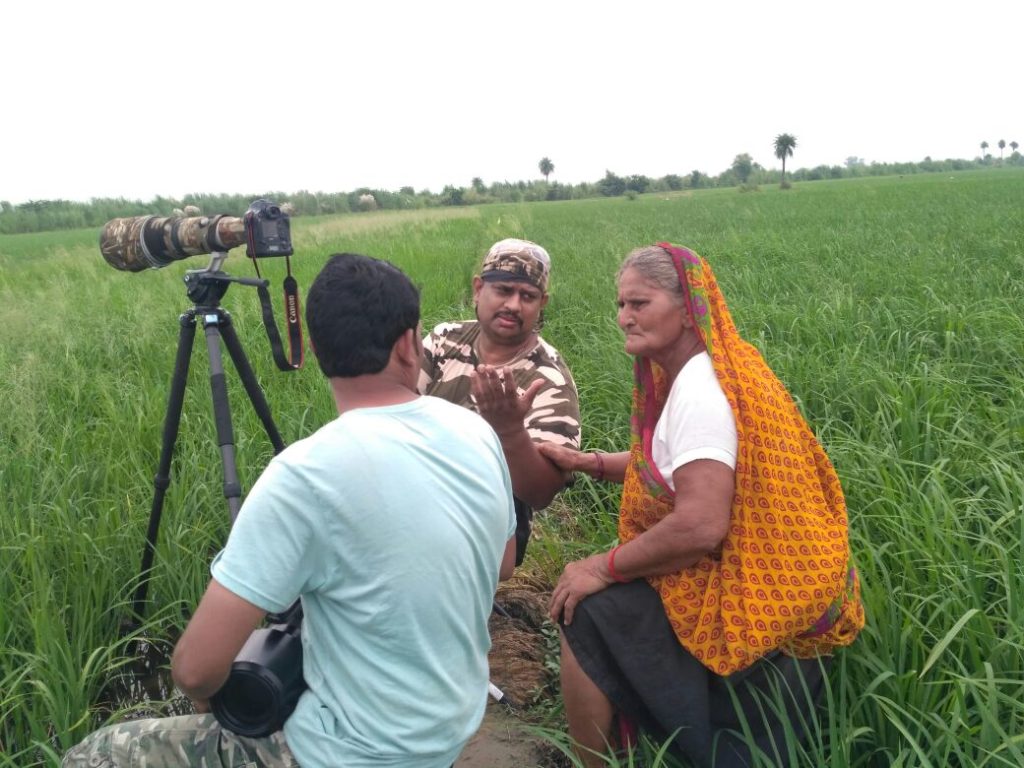 With the amma who owned the field .She gave us lot of information on the bird. She was happy to have the birds in her field. The next day was a festival and she cooked us sweets and gave us blessings. This is perhaps a more humbling moment in this project.
With the amma who owned the field .She gave us lot of information on the bird. She was happy to have the birds in her field. The next day was a festival and she cooked us sweets and gave us blessings. This is perhaps a more humbling moment in this project.
In all this project was a very satisfying one and perhaps the hardest and dirtiest one I have undertaken till now
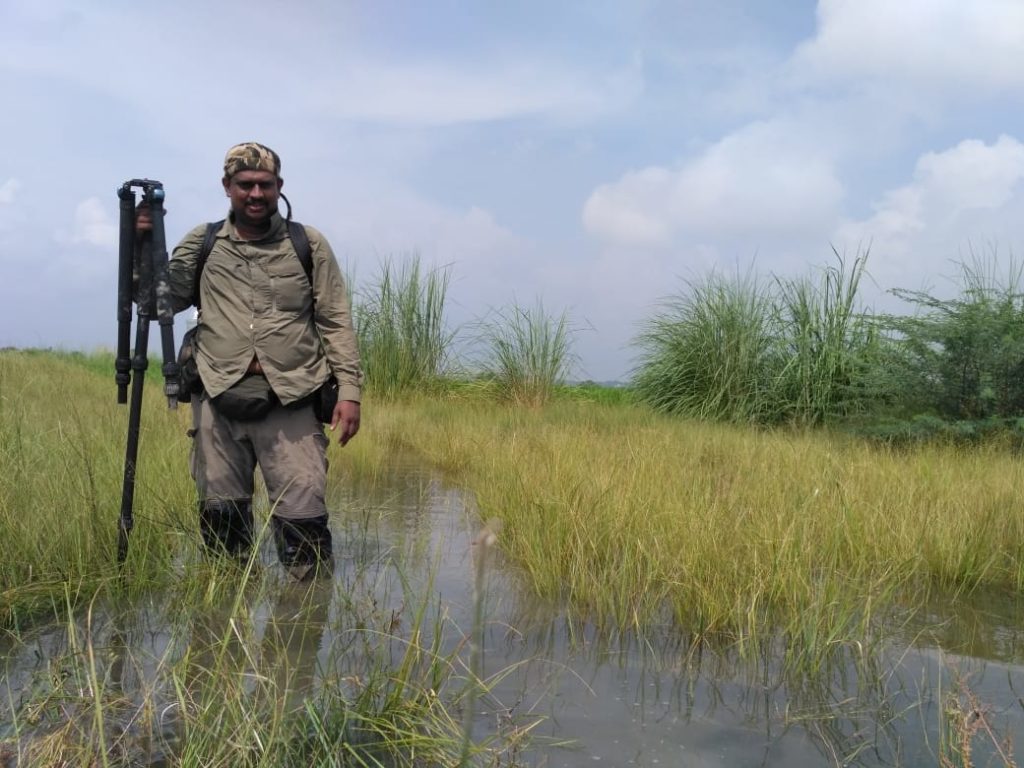 But every inch of the mud on my body was worth the experience.
But every inch of the mud on my body was worth the experience.
All this was possible thanks to the dedication of the “Saras Man” Chottu Afzal Khan… I am yet to meet a more dedicated bird man than him. It is a pleasure to be with this gem of a person even if you are not clicking the birds.
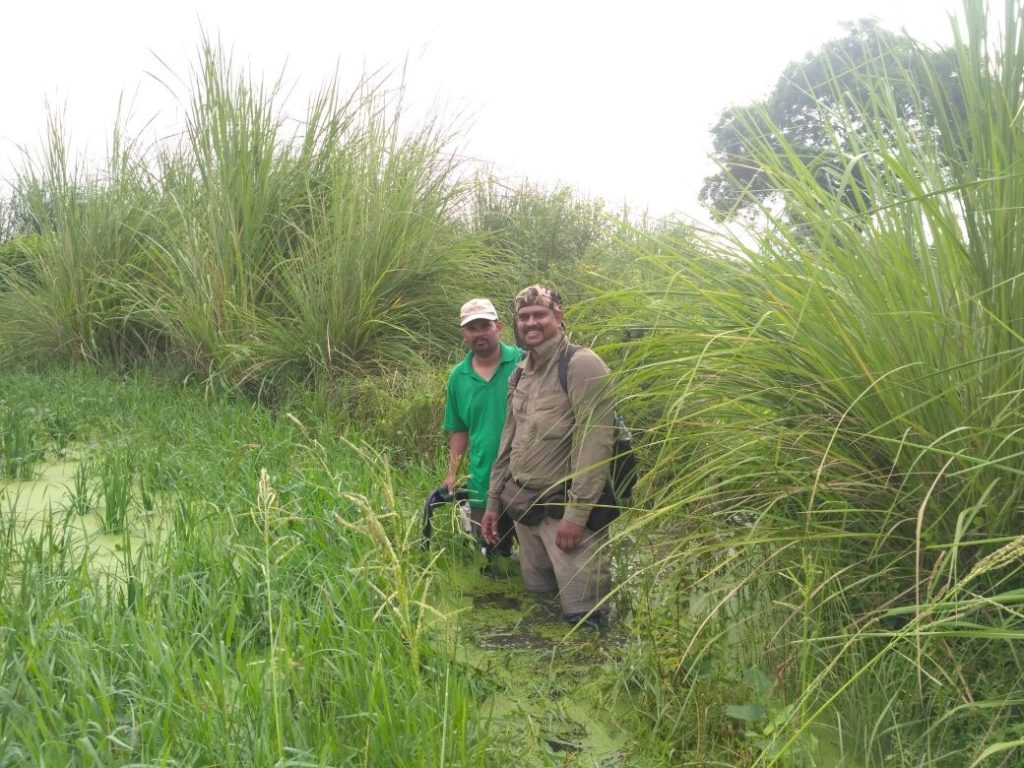 Getting hands dirty for your dreams is a blessing only the lucky ones get ( with the “Saras man” Chottu Afzal Khan)
Getting hands dirty for your dreams is a blessing only the lucky ones get ( with the “Saras man” Chottu Afzal Khan)
We were also helped by Gajendar Singh. He was a key person for us to identify the nest and more importantly walk in front of us to guide us through the treacherous route. He took all the pit falls on the path and showed us the route. A big heartfelt gratitude to both these gentlemen.